Leading a healthy life is a modern and very popular trend increasing the demand for medical and fitness tracking apps. All such applications are designed to collect and analyze information about various users' activities - and, of course, the process would be much more convenient if there is one common storage platform. Previously, the task was difficult to implement, but now, thanks to the HealthKit and Google Fit frameworks, it's much easier to achieve the desired goal. And you can offer your users exactly what they want to have: an excellent mobile solution that allows processing their fitness data in one single place.
Digital healthcare market leaders and owners of medical devices and software have already started to apply Google Fit & HealthKit in practice, and very successfully, we should say. A prime example is Withings, a company that manufactures smart gadgets to track physical activity. What's more, Adam Lin, president of iHealth, claims that HealthKit and Google Fit are going to completely change the healthcare industry, and for the better. Hire a developer of custom mobile app development services to incorporate HealthKit and Google Fit on fitness applications.
Anyway, health and fitness apps are now easier and cheaper to build. And that’s definitely good news!
Surely, it remains to be seen whether these frameworks are suitable for your specific goals. We hope our article will help you figure this issue out.
Health and Fitness Apps Plus HealthKit and Google Fit
All medical and gym trainer apps are collecting fitness data, and in the old days (before Apple and Google came up with the solution), it had to be stored in different places, which is hardly convenient. Some popular healthcare platforms (such as Fitbit) managed to find a way out, but still... the situation seemed unfortunate.
Luckily, today we can store health and fitness data together, no matter what fitness activity trackers and devices we use. Also, the development process, as we mentioned above, has become easier. It is enough to resort to the HealthKit and Google Fit frameworks to solve a number of problems (those that are just related to the storage and processing of healthcare information).
But let's go deep into the issue. You’ll find it interesting (especially if you’re going to create fitness apps for Android or iPhone).
Google Fit
Google Fit is responsible for gathering and storing data on the health and activity of Android smartphones users, which is possible thanks to special sensors built into devices. It's about collecting such information as the number of steps taken, heart rate, and much more (every little detail, which allows assessing how active the user is and whether he is feeling well).
And if a developer is creating Android-focused medical and fitness tracking apps, he can get this useful health data through Google Fit.
HealthKit
All Apple devices have a default Health application, which collects data on the user's physical activity and well-being (with his consent). And using HealthKik allows developers to access this data to build various activity tracker apps and create medical devices and software with less effort.
HealthKit & Google Fit Benefits
Let's talk about health tracker app developers and users and the benefits they get.
-
Both tools store health and fitness data from a variety of sources. And the formed single storage place simplifies the creation and use of medical and gym trainer apps:
-
Developers now get by with fewer lines of code, and no complicated integrations are required either.
-
A user can easily download any health and fitness apps, they sync with each other without his manual assistance.
-
-
Fitness apps for iPhone and Android freely exchange data, which means they work more productively and bring more benefits to users.
Well, we've figured out the basics. And hopefully, now you understand what Apple and Google solutions are at their essence and how they are similar. Now it’s time to discuss their differences, which also exist (the most obvious one is their compatibility with different operating systems, but there are many more things to talk over in this regard).
HealthKit & Google Fit: Key Differences
We're going to detail the way these solutions interact with fitness and health tracker apps. We'll explain to you how they receive and process health data so that you'll see what we're dealing with in each case.
BTW!
Whereas HealthKit focuses on information about the user's health (as the name suggests), Google Fit operates on fitness data of a standard nature (again, see its name). However, you'll seize the point after reading our analysis to the end.
Gathered data
iOS devices collect much more data on the user's health and activity compared to Android smartphones.
Let’s take a deeper look at the issue, shall we?
HealthKit
The standard Health app is gathering the following information about the user:
-
Activity. How active is the user during the day? How many steps does he take? The iOS smartphone collects this data and combines it with the information provided by other sources (such as activity tracker apps), after which it is available for use.
-
Sleep. Apple's Sleep Mode analyzes the user's repose process. However, he can take advantage of any other device to monitor the way he feels during sleep. All the data will sync with each other.
-
Mindfulness. Apple encourages its users to engage in various meditation practices designed to calm their minds. In particular, it monitors (through its devices) how much time they spend on mindfulness techniques.
-
Diet. Again, the data the Apple system gathers on the user's nutrition (say, the number of calories consumed) is being combined and synchronized with similar information received from other diet apps and popular healthcare platforms.
-
Other health & fitness data. It would take a long time to list all kinds of information the Health app from iOS collects and processes. It includes heart rate, blood pressure, reproductive health, and more.
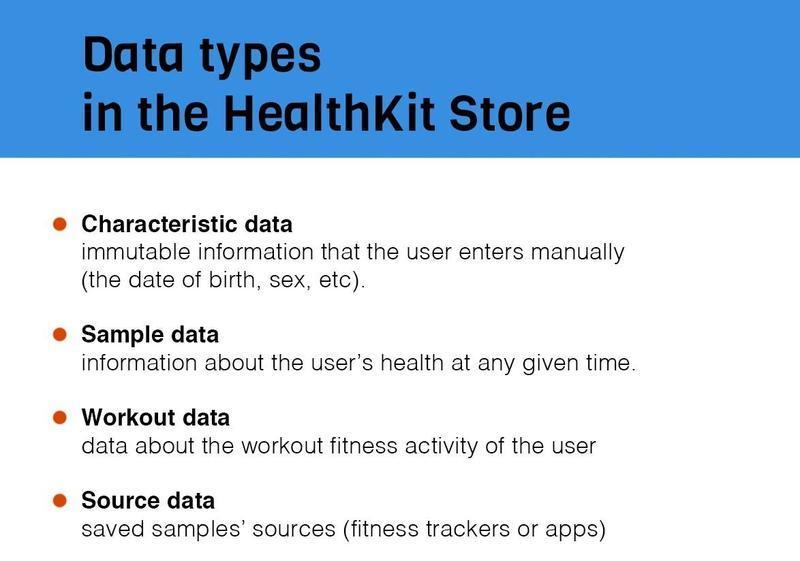
All the information is backed up in an encrypted form in the iCloud space.
Google Fit
Now let’s discuss Google Fit and the data types it stores:
-
User location. Using GPS sensors, the smartphone tracks the user's location (if he doesn’t mind providing such information). The result is a general idea of how many miles he has walked in a day (or, say, cycled).
-
Physical activity. The aforementioned location data can also be helpful for collecting information about the user's activity routine. Everything that can be considered a sports activity is being taken into account (walking, running, cycling, gym...).
-
Drinking & Eating pattern. Like Apple, Google helps users watch what they eat. All dietary data is being obtained from a variety of medical and fitness tracking apps.
-
Data from body sensors. It all depends on the metric the sensor monitors (say, the pulse).

When it comes to fitness apps for Android and how they interact with Google Fit and work with data, there are 2 main options:
-
information is being exchanged between all health and fitness apps the user deals with;
-
one or more applications don’t allow the use of their data, and the exchange of information between the Google Fit app and other services becomes imperfect.
All the information is protected and cloud-stored.
UI/UX
The clearer and more appealing the interface design, the easier it's to deal with and the better the user experience. That's why Apple's Health and Google Fit app have put a great focus on UI/UX.
HealthKit
Apple is famous for its love of clean and simple interface lines. That's why users, opening the Health application, may feel surprised and even discomforted: in the first minutes, the service seems too complex and unnecessarily detailed. However, it's far from the case: Health's UI is designed to trifles, all the wishes of users have been taken into account. For example, there is a feature helping to compare data in the most convenient way.
Convenience lies in the fact that compared information can be sorted according to some criteria, be it a time period or something else, and studied on a single screen. In addition, the user will be informed what other fitness apps for iPhone and gadgets are working with the HealthKit system.
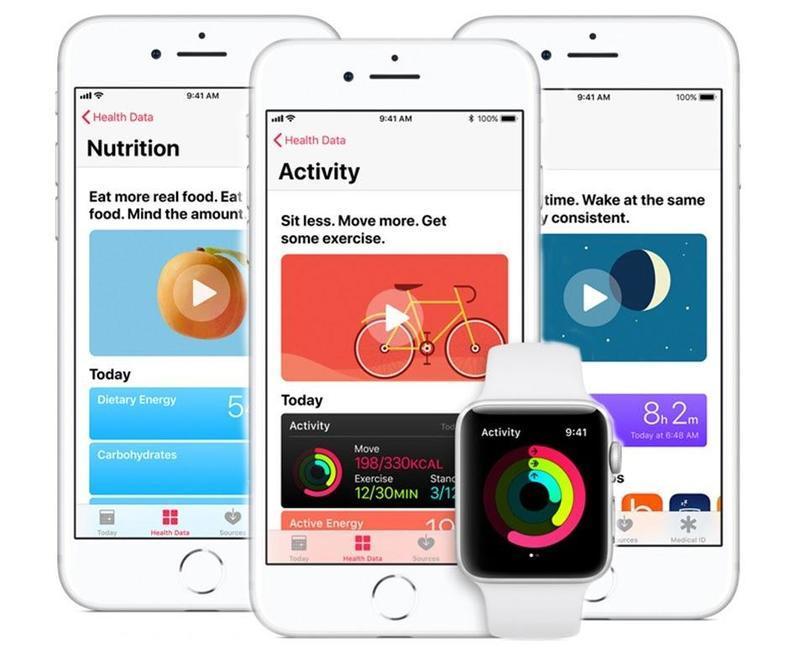
Google Fit
Google Fit app's UI is also quite user-friendly and pleasing to the eye, but it lacks the intuitiveness of Apple's approach. Among other things, the above comparison of data is more difficult in the case of Android devices. The user has to constantly switch between screens, which is hardly convenient and takes up extra time.
But there are also positive aspects: say, Google makes good use of various graphic elements to explain to the user what his further steps and actions should be.
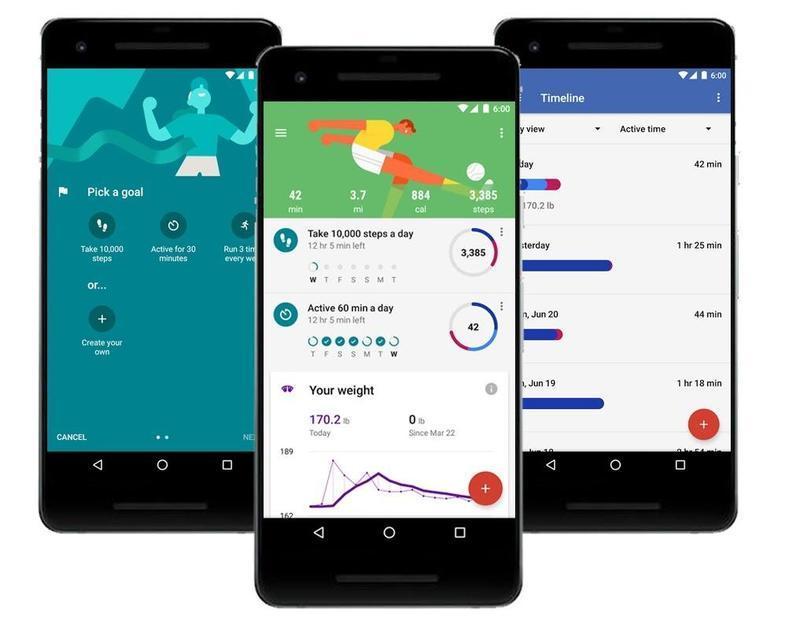
Security & Use Conditions
If you don't mind using HealthKit and Google Fit to build your own activity tracker app, take a moment to review the terms of use for these services. Google and Apple offer detailed guides to help you understand this issue from A to Z, so it won't be a problem. And why not start with our brief analysis of both systems?
HealthKit
Apple pays special attention to the protection of data used by medical and fitness tracking apps. It is the need to secure information that leads to some restrictions on the use of HealthKit (quite logical and reasonable ones):
-
only lifestyle-related apps. To be precise, only medical and fitness apps for iPhone can access data through HealthKit. For example, a banking application doesn’t need information on the user's physical activity, which means it won’t have access to it (unless its creators can argue why the program needs this kind of data).
-
no ads! Do you have an idea to advertise your health tracker app using HealthKit (or rather, through user data it gives access to)? Alas, that's not happening: such activities are strictly prohibited by Apple.
-
user consent is a must. The activity tracker application is obliged to ask the user for access to his data. If he denies it, even HealthKit won’t help to get the desired information.
-
By the way, if the user allows, you can apply his data obtained with HealthKit to take part in all sorts of noble causes such as medical research.
-
-
no plagiarism allowed. Your medical or gym trainer app must have its own unique design, you cannot use the UI elements inherent in the Health Service (the same applies to the term HealthKit itself).
-
clarification. Detail the user why you need data about his activity. Make it clear what his personal benefit is. By doing so, you increase the chances of getting his permission to access his HealthKit information.
Google Fit
In many ways, Google's requirements are in line with those put forward by Apple's company. Say, the No Ads rule is also relevant (you cannot promote health tracker apps using Google Fit).
But let's discuss it in more detail:
-
Be sure to ask the user if he doesn't mind providing access to his Google Fit app data;
-
Google Fit can and should be the backbone of fitness apps for Android, but don’t use it to create an API for sharing user data with third parties;
-
In some ways, Google's requirements differ from those of Apple's. Among other things, you’re allowed to use Google Fit for more than just developing medical or fitness apps. However, be careful and don’t abuse Google's trust: no gambling services or anything like that!
-
Also, you have to make sure the use of your mobile application isn’t capable of damaging the person in one way or another (not everything is within your power, but do your best to deliver that).
-
Other details of the prohibitions of using API can be found here.
Examples of health and fitness apps
If you want to create a successful activity tracker app, you should look at your potential competitors. And we are ready to give a few examples of popular healthcare platforms.
Of course, far-sighted applications provide support for both platforms; however, we‘ll consider the most popular services for Apple and Google separately.
HealthKit:
-
MyFitnessPal is a well-known application for monitoring calories consumed and the nutritional value of food. The user manually enters everything that he has eaten, and HealthKit allows tracking this information in one place.
-
Thanks to Strava, users can track their sports activity, and the data can be conveniently viewed in the Health application.
-
CARROT Fit gives users the opportunity to enter information about their workouts and scolds (yeah, it scolds!) when skipping sports activities. CARROT Fit integrates with HealthKit and takes the data placed by other gym trainer apps. In addition, the service comments on user achievements.
Google Fit:
-
Noom is a "personal dietician" aimed at helping to reduce the number of bad habits and increase the number of good ones, those which contribute to a healthy process of losing weight. Noom does not have its "own" gadgets but it can integrate with Google Fit too.
-
Runtastic offers a full range of applications for tracking lifestyle and physical activity. Runtastic takes the statistics from other health and fitness apps and sends its data, so it's no surprise that it readily integrates with Google Fit.
-
Mi Fit is an application for Xiaomi mi band, a cheap fitness activity tracker with a wide range of features. The service data can be transferred to Google Fit.
Monitoring your competitors is a useful practice that allows correcting your own marketing strategy on time. However, before you compete with anyone, it is useful to create your own product - a competitive health tracker app.
How to use HealthKit and Google Fit in your app
And now we've come to grips with the core question of the issue: how to create the most accurate fitness tracker apps with the help of HealthKit and Google Fit? Of course, we'll not go into all the details, we'll tell only the very essence.
HealthKit
As you now understand, the HealthKit service provides a technical platform, a repository that fitness apps for iPhone & Apple Watch can use to share health and fitness data.
![]()
You do not need to collect such data on your own and look for ways to store this information. Also, you do not need to build analytical infographics based on the data obtained - HealthKit will do everything for you. And you can devote your time and effort to more pressing issues and thereby improve the user experience in another respect.
What is the HealthKit framework?
HealthKit itself is a hierarchy of immutable classes inherited from the abstract HKObject class. In fact, the HealthKit framework controls and structures the data types so that any fitness app can easily figure out the best way to use them. Developers do not have the right to create custom data types and units, instead, they should take advantage of those that HealthKit offers.
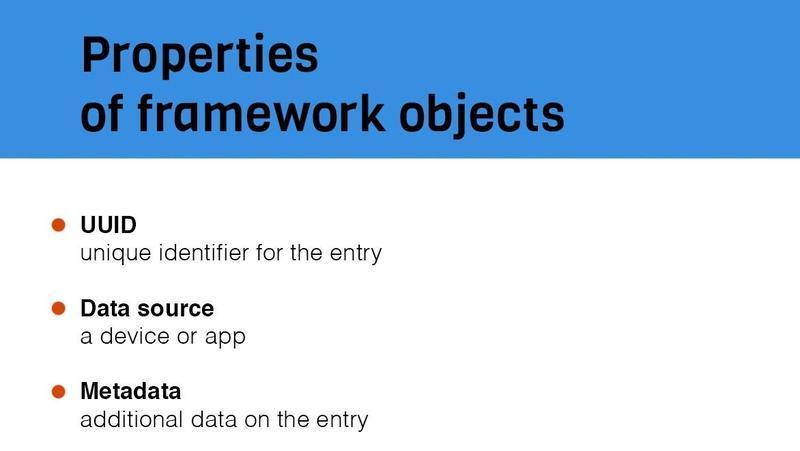
As we’ve said earlier, data objects are of 2 types: unchanged over time and allowing the addition of new data.
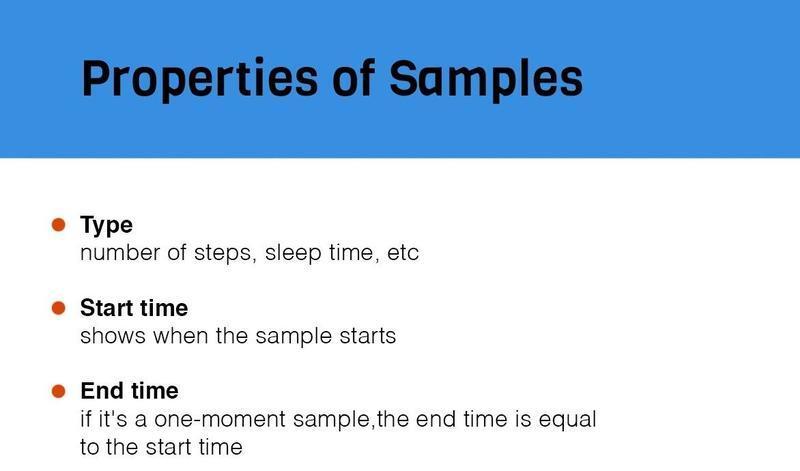
All these objects, units, and classes help structure the data so that third-party health and fitness apps have the opportunity to deal with the HealthKit service and exchange information with each other in the most effective way. And developers no longer need to look for solutions to establish such interaction.
Need more information on the matter? Then, we suggest that you study the documentation. Although it is much wiser to hire a developer who will help you in creating medical and fitness tracking apps.
Google Fit
GoogleFit is a fairly small and well-structured platform with a detailed software manual. It allows getting healthcare data from various sources such as smartphones’ sensors, smartwatches, fitness bracelets, and so on. GoogleFit stores the health and fitness data in cloud storage, and fitness apps for Android can approach it quite easily.
![]()
Integrate your activity tracker app with the Google Fitness API (the native API for Android or the REST API for developing a web client) and enjoy the result. The Google Fit app will assume most of the work.
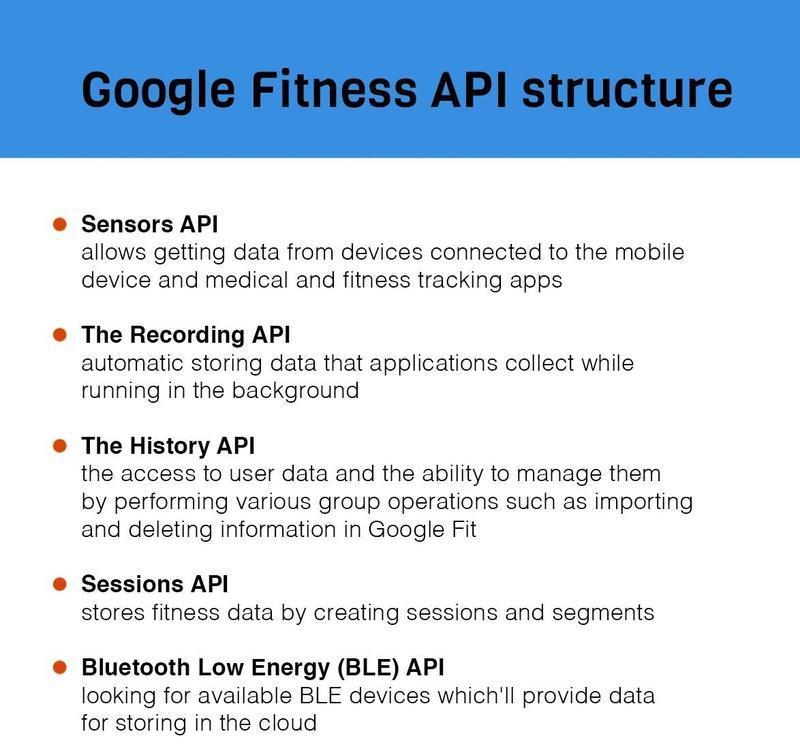
Other ways to collect data on user activity
Of course, HealthKit is not the only option to get data about user activity (when it comes to the iOS platform), neither is Google Fit for Android. For example, Withings Health Mate takes advantage of Bluetooth or Wifi to receive information obtained by using the Withings Smart Body Analyzer or another device of this brand. Naturally, this approach does not allow synchronizing the work of several health tracker apps, which is less convenient for the user and reduces the capabilities of the mobile service itself.
We, too, faced the need to receive data without the help of APIs that Apple or Google provide. In particular, this need arose when we were working on the application that accesses third-party fitness activity trackers via the API, requests user activity data, and credits them with bonuses, so-called "Points". In fact, our application simulates a fitness tracker.
We should have integrated a few most accurate fitness trackers and popular healthcare platforms such as iHealth, Fitbit, Jawbone, Garmin, and Moves to get all possible data about the user's activities: how much he walked, ran, cycled, slept, etc. for the last year. Further, these data had to be processed by a special formula, which the client provided us with. The formula proved to be ineffective and led to inaccurate results, and our team worked really hard to improve it. We achieved what we wanted (or, rather, what our client wanted), but the task was not an easy one. Of course, HealthKit and Google Fit would have greatly simplified our work.
A couple of tips for the last
These few tips will help you create health and fitness apps able to lead to the best user experience:
-
Request access to users’ data only if you have a reasonable excuse. If the gym trainer app requests access to information that has nothing to do with physical activity, users are less likely to trust this application with their personal data.
-
Give users a chance to understand how their health data will be used. For example, when a user fills a profile in a weight loss app, it is reasonable to ask for access to the weight information being stored in the Health application.
-
Take advantage of the system user interface when requesting personal data. This is exactly what the user expects, and one should not disappoint him. By the way, if the user wants to stop sharing data with your activity tracker app, he makes this change in the Settings of his smartphone. There is no need to include such a feature when building your app UI.
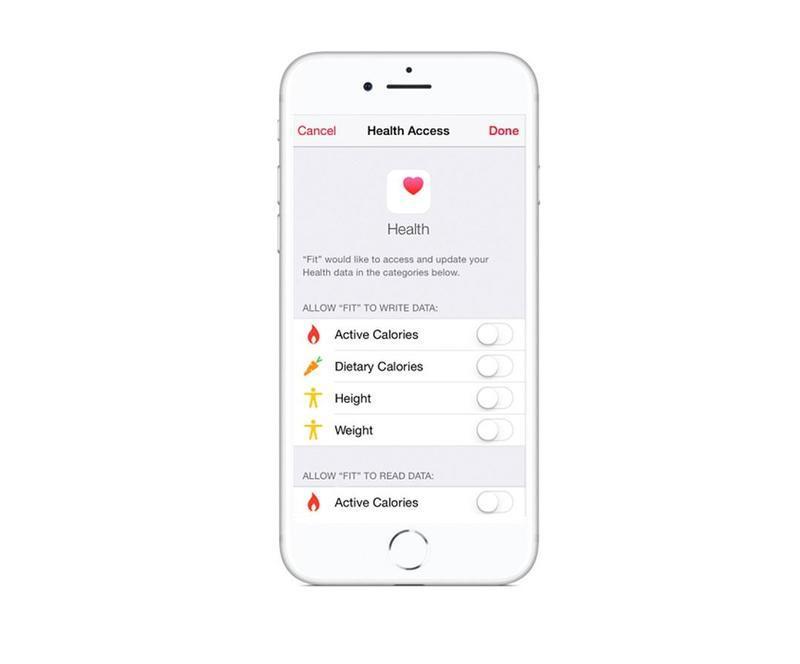
So, if you need to develop fitness apps for Android or iPhone and you want to achieve your goal as quickly as possible (and at no extra cost), do not neglect the help that Apple and Google so generously offer. Be sure to follow all the conditions of confidentiality and try to provide the best user experience.
Of course, you will need the assistance of developers, and we’ll be glad to become your contractors. Our team has successfully been working with health and fitness apps, which means that we have both theoretical and practical experience. We know how to create an application that will work without errors and effectively.
Looking forward to communicating with you!

